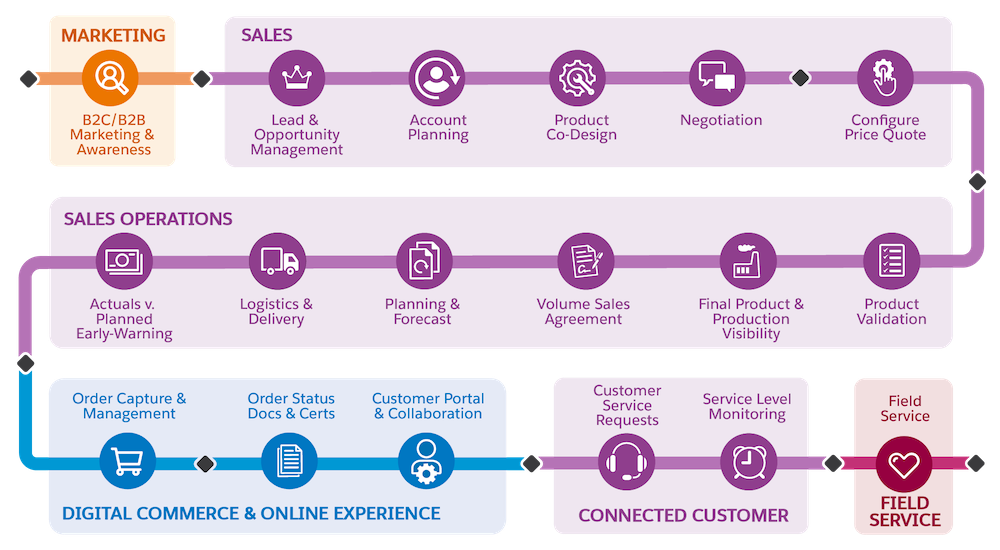Meet Manufacturing Cloud
Learning Objectives
After completing this unit, you’ll be able to:
- Outline the latest trends in the manufacturing industry.
- Describe a typical manufacturing company and its business units.
- List common challenges that a typical manufacturing company faces and possible solutions.
- Explain how Manufacturing Cloud empowers sales, operations, and service teams.
Explore the Manufacturing Industry
Manufacturing is one of the oldest economic activities in the world. But this age-old industry is undergoing some significant transformations in the digital era. According to Inside Salesforce’s New Trends in Manufacturing Report, recent tectonic shifts in the global economy have underlined the need for manufacturers to build resilient, versatile value chains. Here are some key trends that are shaking up the industry.
- Digitization of commercial operations: Manufacturers must adapt against potential disruptions, protect their bottom line, and optimize for growth. From the factory floor to the corporate office, manufacturers have accelerated the digitization of commercial operations to become more agile, resilient, and secure. Digital transformation has helped boost sales, optimize inventory, automate processes, enable self-service, and more.
- Siloed teams and processes: Siloed teams are failing to keep up with the changing business environment. Incompatible goals, fragmented sales processes, multiple revenue models, disconnected order-capture channels, dispersed customer data, and limited supply chain visibility lead to an inconsistent perception of customers and substandard performance. Manufacturers are moving toward building a culture of collaboration, unifying goals, and connecting teams.
- Dissatisfaction with traditional demand forecasting: Manufacturers are deeply dissatisfied with the patchwork approach to sales forecasts for their dynamic enterprise businesses. Traditional forecasting solutions exist across a clutter of spreadsheets, enterprise resource planning (ERP) systems, computerized maintenance management systems (CMMS), and accounting software. To make demand planning more accurate, manufacturers are prioritizing the optimization of their forecasting capabilities.
- Enhancement of the customer service experience: Manufacturers are eyeing customer service as a critical area to enhance their products’ value proposition and nurture relationships with customers. Future-ready manufacturers are keen on delivering personalized, seamless, and memorable service experiences to their customers.
Let’s look at how a typical manufacturing company is impacted by these trends.
Get to Know the Folks at Rayler Parts
The manufacturing industry is abuzz with original equipment manufacturers (OEM), dealers, production suppliers, distributors, retailers, aftermarket manufacturers, and other manufacturing businesses large and small. One of these companies is Rayler Parts.
Rayler Parts is a pioneering manufacturer of construction equipment. As an OEM, Rayler Parts manufactures heavy machinery, sells it to a global network of distribution partners, and services the machinery.
Rayler Parts has two business units: a sales unit and a service unit.
- The sales unit manages one-off and run-rate business. It charts out long-term business agreements with distributors, tracks partner compliance, creates demand plans, collaborates with key accounts, and monitors distributor performance.
- The service unit is responsible for resolving queries from partners, managing product warranties and claims, and tracking their spare parts inventory.

Let’s explore how Rayler Parts conducts its day-to-day business.
Dive Into a Manufacturer’s Problems
Rayler Parts has been using Salesforce Sales Cloud for quite some time. Cindy Jones is the admin extraordinaire at Rayler. She’s adept at analyzing business needs and mapping them to Salesforce capabilities. In response to challenges and queries from various team members, she plans to implement and adopt new Salesforce features.
Recently, Rayler introduced a new product line of diesel and alternative-fueled generators, which has taken off in key markets. As business skyrocketed, the needs of the sales and service teams evolved.
Instead of tackling the firehose of requests one at a time, Cindy decides to survey key stakeholders and understand the bigger picture. She enlists Elliott Park, Head of Sales, AMER, and Najma Omar, VP of Service, to understand the demands of their respective teams and ideate possible solutions.
After surveying team members, Elliott and Najma meet Cindy to discuss their findings. Elliott begins by discussing the problems that the sales unit faces.
| Problems | Possible Solutions |
|---|---|
|
Account executives don’t have at-a-glance visibility into purchase commitments and customer compliance. |
A single view of agreement terms and compliance for product quantities and revenues. |
|
Account executives lack the flexibility to change sales plans based on factors such as production issues, customer requests, and recession. |
The ability to adjust planned quantities, sales prices, and discounts with ease. |
|
Account managers can’t easily see product inventory levels. |
Metrics for inventory similar to the existing pricing and quantity metrics. |
|
Account executives need to manually update actual product quantities based on fulfilled orders. |
A seamless way to pull information from orders and automatically update sales plans. |
|
Account managers can’t create and assign targets to their team members. |
An easy way to create and distribute targets across team members. |
|
Account managers can’t generate separate forecasts for different teams, products, and regions. |
A holistic forecasting framework that can work with complex requirements. |
|
Account executives struggle to set up and allocate incentives to partners. |
An easy-to-configure solution that helps managers create and manage personalized rebates for partners. |
Next, Najma outlines the service unit’s problems.
| Problems | Possible Solutions |
|---|---|
|
Service reps have to review multiple records to understand and resolve a customer request. |
A unified view of customer activity and tools to resolve queries. |
|
Warranty administrators capture warranty information for assets in different places and misplace details. |
A way to track the warranties of each asset with granular details on eligibility and entitlements. |
|
Warranty claims adjudicators struggle to gather sufficient information for warranty claims. |
The ability to capture warranty claims with granular details on defective products, existing coverages, and more. |
|
Service managers can’t predict the demand for spare parts. |
A holistic forecasting framework to forecast spare parts. |
Finally, Elliott and Najma share some common problems that both the sales and service units face.
| Problems | Possible Solutions |
|---|---|
|
Managers find it complicated to coordinate and track visits to partners. |
A flexible framework that helps managers track field rep visits and lets field reps capture key visit details. |
|
Team members have to manually perform many recurring tasks, which introduces errors. |
Dynamic tools to automate workflows, repetitive processes, and calculations, and to support decision-making. |
|
Account managers and service managers have a hard time collaborating with partners in real time on agreements, forecasts, warranties, and incentives. |
An online portal for partners and manufacturers to collaborate. |
|
Team members don’t know how to analyze vast and complex data. |
A tool that breaks down complex data, converts it to easy-to-understand visuals and helps managers derive key insights. |
Cindy faces a tall task. She reaches out to the Salesforce account executive for Rayler Parts to check if Salesforce has a solution.
Step Into a Manufacturer’s Paradise
The account executive introduces Cindy to Manufacturing Cloud. It’s a dynamic platform that helps manufacturers manage their entire book of business, deliver memorable service experiences, and build meaningful relationships with partners. Manufacturing Cloud is built on top of Sales Cloud and Service Cloud. It comes with objects, features, tools, apps, components, workflows, and other configurations tailored to the specific needs of the manufacturing ecosystem. The solution empowers teams to collaborate across the complete manufacturing lifecycle.

Sales, operations, and service teams can use Manufacturing Cloud to fuel business growth, streamline operations, and deliver excellent customer service. It can unify back-office data on orders and inventory with front-office data on sales agreement negotiations. And with additional Salesforce capabilities, companies can strengthen their marketing, digital commerce, and field service teams. The features available to you depend on whether you’ve implemented Manufacturing for Sales, Manufacturing for Service, or Manufacturing for Sales and Service.
Cindy is delighted to learn about Manufacturing Cloud and believes that Rayler Parts should implement Manufacturing Cloud for Sales and Service. After extensive research, she’s ready to introduce this shiny solution to Elliott and Najma.
In the upcoming units, follow Cindy as she describes how Manufacturing Cloud can help Elliott’s and Najma’s teams.